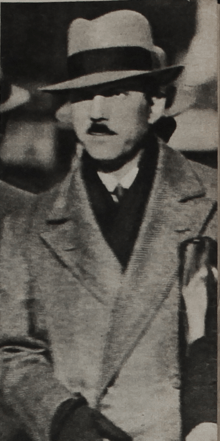Pierre Bonny
| Pierre Bonny | |
|---|---|
 Pierre Bonny in 1934 | |
| Born |
January 25, 1895 Bordeaux, France |
| Died |
December 26, 1944 Fort de Montrouge, France |
| Cause of death | Sentenced to death |
| Nationality | French |
| Occupation | Policeman |
Pierre Bonny (1895[1] – December 26, 1944), born in Bordeaux, was a French police officer. As an inspector, he was the investigating officer on the 1923 Seznec case, in which he has been accused of falsifying the evidence.[2][3] He was praised as one of the most talented police officers in the country helping to solve the notorious Stavisky financial scandal in 1934.[4] In 1935 he was jailed for 3 years on corruption charges.
During the Second World War, Bonny joined the French Gestapo, known as the Carlingue. He was executed by firing squad in 1944.[5]
Besides the overwhelming memory of a traitor and unscrupulous collaborator, he commonly incarnates the figure of a corrupt man, the executor of the lower works of the Vichy regime.
He is held to be the basis for the character of Monsieur Philibert in Patrick Modiano's wartime-set novel La Ronde de Nuit.[6]
References
- ↑ Pierre Bonny entry at France Justice
- ↑ Between Justice And Politics: The Ligue Des Droits De L'Homme, 1898-1945, William D. Irvine, Leland Stanford Jr University, 2007
- ↑ The French Against the French: Collaboration and Resistance, Milton Dank, J. B. Lippincott Company, 1974, p.214
- ↑ Mug shots: an archive of the famous, infamous, and most wanted, Raynal Pellicer, Abrams, 2009, pp.125-127
- ↑ The French Against the French: Collaboration and Resistance, Milton Dank, J. B. Lippincott Company, 1974, p.221
- ↑ Vichy's Afterlife: History and Counterhistory in Postwar France, Richard Joseph Golsan, University of Nebraska Press, 2000